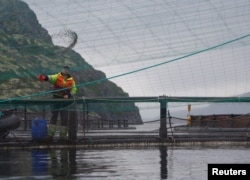Arctic fjords that hid Soviet nuclear-powered submarines during the Cold War are now being used as a weapon in the sanctions war with Europe - to rear fish that Russia can no longer import.
Three years ago, Russia banned food imports from the West in response to a series of Western sanctions that aimed to punish Moscow for its role in the Ukraine crisis, including its annexation of the Crimean peninsula.
Trout and salmon, grown specially for Russia's vast market at farms in Norway next door, were among the first victims of the sanctions war.
Moscow's ban on the largest exporter of red fish to Russia led to a sharp hike in prices, while also offering lucrative prospects for Russian fish farmers.
In the Murmansk region in Russia's northwest, where the rocky coastline of the Ura Bay still features deserted Soviet-era bases and top secret berths for today's submarine fleet, huge fish farming cages are now becoming part of the landscape.
Thousands of adult trout and salmon swarm inside the open-sea cages as workers toss in generous portions of high-calorie feed.
The cages belong to Russian Aquaculture which farms salmon and trout in the Barents Sea off Murmansk and in Russia's northern Karelia region.
When they mature, the fish are loaded onto special ships and, still alive, are brought to a Murmansk factory for processing.
Here the fish are either deep frozen or turned into filets and steaks.
Russian Aquaculture reared fish before the Ukraine crisis but under a different name. Once the sanctions were introduced, it increased production to fill the gap in the market previously occupied by Norwegian imports.
The company's drive to increase output hit difficulties in 2015 when many of its fish succumbed to diseases. It says it has now overcome those problems, and is pushing hard again to produce more fish.
Over the next five to 10 years, Russian Aquaculture aims to ramp up its output to produce 25,000-30,000 tons of fish per year. In the first half of this year, the company produced 8,400 tons of fish.











